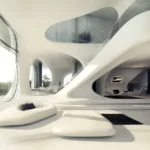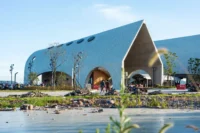The way we design and live in cities is changing faster than ever. With groundbreaking technologies and innovative architectural approaches, our urban spaces are transforming to meet the demands of a rapidly evolving world. From smart infrastructure to sustainable designs, the future of cities promises to reshape how we interact with our surroundings.
As we embrace this new era, modern architecture is stepping up to create spaces that are not only functional but also environmentally conscious and adaptive. These advancements aren’t just about aesthetics—they’re about building cities that are smarter, greener, and more connected. The future of urban living is here, and it’s redefining how we think about the places we call home.
The Intersection Of Technology And Modern Architecture
Technology and modern architecture are reshaping cities, focusing on efficiency, sustainability, and advanced functionality. This relationship defines new urban environments that merge intelligent design with cutting-edge technology.
How Technology is Transforming Urban Living
Modern cities integrate technology to improve everyday experiences and enhance urban functionality. Smart grids, for instance, optimize electricity usage by analyzing consumption patterns, reducing energy waste. Autonomous public transport, such as self-driving buses, increases accessibility and reduces congestion. IoT-enabled devices manage water systems, ensuring distribution efficiency and minimizing wastage.
Building management systems (BMS) use AI to monitor energy and climate control, adjusting in real-time to improve comfort. Technologies like AR and VR support urban planning by visualizing designs before construction. These innovations contribute to livable, efficient, and connected urban living standards.

Architectural Innovations For Smart Cities
Architects employ innovative techniques to meet the demands of smart cities. Green roofing systems, for example, incorporate vegetation to lower heat absorption and support local biodiversity. Dynamic facades adapt to environmental conditions, using sensors to control light intake, which optimizes energy usage.
Structures featuring 3D-printed components reduce material waste and accelerate construction. Integrated solar panels in buildings generate renewable energy while complementing architectural aesthetics. Floating city concepts showcase modular designs, allowing scalability as urban populations grow. These architectural advancements align with technology to support smart, sustainable city development.
Sustainable Design In The Future Of Cities
Sustainable design plays a key role in shaping future urban landscapes. Modern cities increasingly focus on eco-conscious solutions that merge functionality with environmental stewardship.
Eco-Friendly Materials And Practices
Using sustainable materials reduces environmental impact in construction. Recycled steel, cross-laminated timber, and low-carbon concrete enable eco-efficient development. For instance, replacing traditional concrete with low-carbon alternatives minimizes CO2 emissions by up to 30%. Green building certifications, like LEED and BREEAM, encourage practices such as sourcing renewable resources locally and optimizing material efficiency. Prefabricated components reduce waste and accelerate construction timelines.
Advanced insulation materials, like aerogels, and cool roofing options improve energy efficiency in buildings. Incorporating vertical gardens and living walls helps regulate temperature and enhances air quality. Biophilic design, including integrating natural light and plant elements in structures, aligns urban growth with ecological principles.
Renewable Energy Integration In Modern Skylines
Modern architecture incorporates renewable energy systems to enhance sustainability. Urban skyscrapers often feature solar panels, wind turbines, or photovoltaic glass to generate clean energy. For example, photovoltaic glazing transforms windows into electricity-producing surfaces while maintaining aesthetic appeal. Rooftop solar setups combined with urban battery storage ensure consistent energy availability even during peak usage.
Net-zero energy designs, which balance production and consumption, drive the adoption of renewable technologies. Energy modeling software optimizes layouts to harness maximum sunlight and wind. Integrating building-mounted wind turbines results in decentralized green energy production. Additionally, geothermal heating systems lower energy costs in mixed-use developments.
By leveraging eco-friendly materials, innovative practices, and renewable solutions, we redefine sustainable urban living while minimizing environmental footprints.

Smart Cities: The Role Of IoT And AI
The future of urban environments relies heavily on IoT and AI to enable smarter, more interconnected city ecosystems. These technologies streamline operations, improve resource allocation, and enhance urban living experiences.
Intelligent Infrastructure Development
IoT sensors and AI-powered systems transform infrastructure by enabling real-time data collection and analysis. Smart grids optimize energy distribution by predicting demand patterns and identifying inefficiencies. For example, streetlights equipped with IoT sensors adjust brightness based on traffic flow, conserving energy.
AI-driven predictive maintenance systems monitor infrastructure health, reducing repair costs and preventing failures. Connected water management systems detect leaks and regulate consumption. Integration of IoT ensures that smart buildings maintain optimal energy usage and indoor climate.
Enhancing Urban Mobility And Connectivity
IoT and AI revolutionize urban transportation systems through automation and real-time monitoring. Autonomous public transport relies on AI algorithms for route optimization, reducing delays and fuel consumption. Smart traffic systems analyze data from connected vehicles to manage congestion and improve safety.
AI-powered mobility platforms integrate ride-sharing services and public transit schedules for seamless travel experiences. IoT-enabled charging stations support the faster adoption of electric vehicles by ensuring access to on-demand charging solutions. These advancements create efficient, sustainable, and accessible urban mobility networks.

Challenges In Implementing Future City Technologies
Implementing technologies in future cities presents distinct challenges that require strategic solutions. From balancing technological advancements with human concerns to addressing financial and infrastructural barriers, cities face complex hurdles.
Balancing Efficiency With Privacy Concerns
Advanced city technologies, such as IoT sensors and AI-powered systems, collect extensive data to optimize operations. These innovations improve resource allocation, urban planning, and public services. However, safeguarding personal data and ensuring secure data management becomes critical to protect residents’ privacy. For instance, smart surveillance systems can enhance safety but might raise concerns about excessive monitoring. Striking a balance between efficiency and privacy calls for robust legislation and transparent governance practices.
Addressing Infrastructure Costs And Accessibility
Building smart cities demands significant investments in next-generation infrastructure and technology. Implementing systems like smart grids, autonomous transport networks, and renewable energy frameworks involves high costs, often requiring public-private collaboration. Accessibility to these advancements also remains a challenge, especially in underfunded or developing urban areas. Equitable access for diverse populations depends on inclusive planning, sustainable funding models, and scalable technical solutions to reduce cost disparities in implementation.
Trends Shaping Modern Urban Architecture
Modern urban architecture reflects innovation and adaptability, addressing challenges like limited space, climate change, and sustainability. Emerging trends redefine how we design and build urban environments.

Vertical Cities And Space Optimization
Vertical cities maximize land use by building upwards, addressing urban density challenges. Skyscrapers now integrate mixed-use spaces, including residential, commercial, and recreational facilities, ensuring efficient land utilization. For example, developments like Singapore’s Marina Bay Sands and Tokyo’s Roppongi Hills demonstrate how vertical architecture provides diversified spaces without sprawling horizontally.
Co-living and co-working spaces in vertical structures promote resource efficiency and community living. Buildings leverage modular construction techniques and 3D printing for faster, adaptable construction. Advanced technologies, such as double-skin facades, enhance energy efficiency by optimizing ventilation and natural light. These innovations support sustainable urban growth and reduce urban sprawl.
Adaptive Architecture For Climate Change
Adaptive architecture ensures structures withstand diverse climatic conditions while reducing environmental impacts. Architects increasingly incorporate dynamic design elements like responsive facades that adjust to weather changes, maintaining internal comfort and energy efficiency. Examples include shading systems that limit solar heat in hot climates or walls designed for thermal retention in colder regions.
Flood-resistant designs address rising sea levels and extreme weather. Techniques such as elevating buildings on stilts or creating permeable ground layers mitigate flooding risks. Materials like bamboo composites and recycled plastics combine durability with eco-friendliness, aligning with climate-resilient building practices.
Smart building systems further enhance adaptability by monitoring environments and adjusting lighting, heating, or cooling based on real-time weather data. These systems optimize energy use, reducing costs and emissions while creating comfortable living environments.
Conclusion
The future of cities lies at the intersection of innovative technology, sustainable practices, and modern architecture. By integrating IoT devices, AI systems, and renewable energy in urban design, we can create smarter and more efficient ecosystems. Technologies like real-time energy management, AI-assisted urban mobility, and smart infrastructure redefine urban living standards while addressing pressing environmental concerns.
Modern architectural advancements, including vertical cities, dynamic facades, and adaptive designs, ensure efficient land use and resilience against climate challenges. These approaches not only enhance aesthetics but also align with sustainability goals by reducing material waste and promoting eco-conscious construction methods.
Balancing rapid technological evolution with privacy safeguards and equitable implementation remains critical as we navigate these transformations. With collaboration across sectors, cities can evolve into interconnected spaces that prioritize functionality, environmental stewardship, and community well-being.















Leave a comment